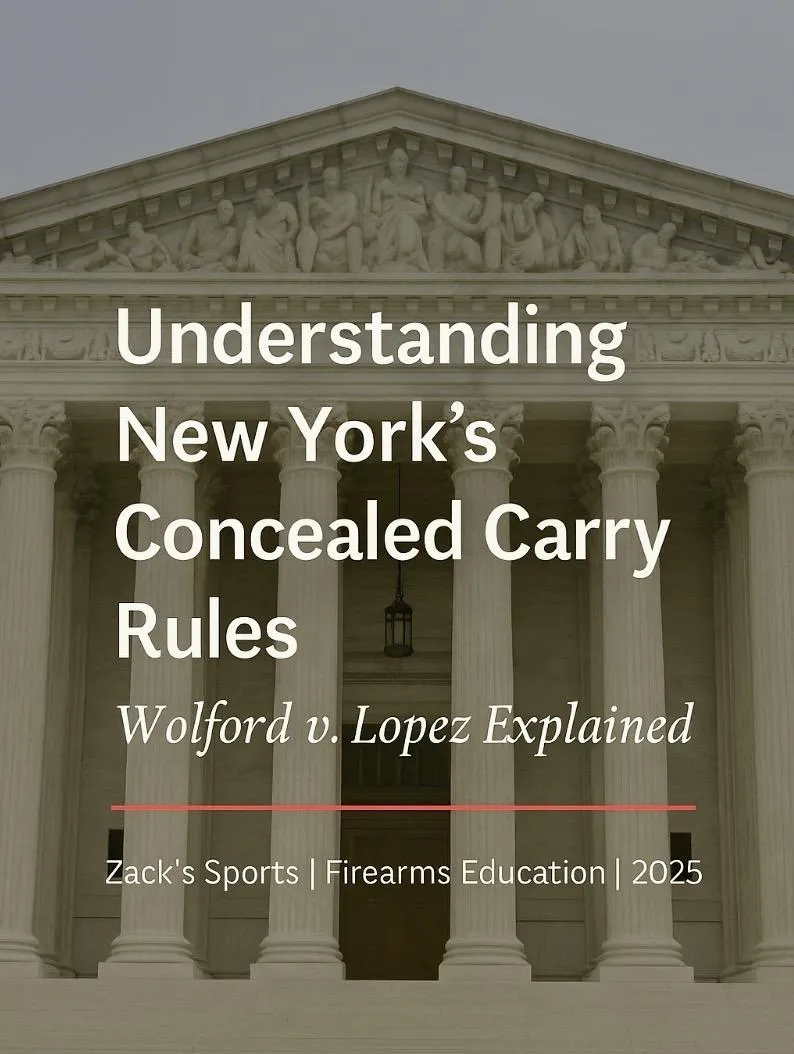
Understanding New York’s Concealed Carry Rules and the Supreme Court’s Wolford v. Lopez Case
Understanding New York’s Concealed Carry Rules and the Supreme Court’s Wolford v. Lopez Case
Posted by: Zack’s Sports
Category: NY Laws | Firearms Education
Date: October 2025
1. What the Law Says (the “Default No-Carry Unless Permission” Rule)
After the 2022 Bruen Supreme Court decision, New York passed the Concealed Carry Improvement Act (CCIA).
One key section says you may not carry a concealed firearm on private property open to the public unless the owner gives express permission — for example, a posted sign or direct consent.
This is often called the “default no-carry” or “vampire rule.” Without that permission, it’s illegal to carry in those locations.
2. The Case of Antonyuk v. James (Second Circuit)
A group of New York gun owners challenged the CCIA, arguing that it violated the Second Amendment.
A district court initially blocked parts of the law, but the Second Circuit Court of Appeals reinstated most of it, including the private-property rule.
Later, after another Supreme Court decision (United States v. Rahimi), the Second Circuit reviewed the case again and reaffirmed its earlier position.
In April 2025, the U.S. Supreme Court declined to hear Antonyuk v. James — so the Second Circuit’s decision stands.
Result: New York’s “permission required” rule remains in effect today.
3. Wolford v. Lopez (Ninth Circuit and U.S. Supreme Court)
In Hawaii, a similar law was passed. The Ninth Circuit Court of Appeals upheld Hawaii’s rule, finding that requiring property-owner permission is constitutional.
On October 3, 2025, the U.S. Supreme Court agreed to hear Wolford v. Lopez — but focused only on one key question:
“Does the Second Amendment allow states to presumptively prohibit carrying handguns on private property open to the public unless the property owner gives express permission?”
This case could resolve the split between the Second Circuit (New York) and the Ninth Circuit (Hawaii/California) on how far states can go with private-property carry restrictions.
4. Where Things Stand Today
✅ In New York:
The CCIA’s private-property rule is still enforceable.
You must see a sign or have permission before carrying into a private business open to the public.
⚖️ At the Supreme Court:
Wolford v. Lopez will decide whether this type of rule is consistent with the Second Amendment nationwide.
The outcome could impact New York, Hawaii, and other states with similar laws.
Key Takeaway for Permit Holders
Until the Supreme Court rules in Wolford, New Yorkers must follow the current law:
• Look for posted signs authorizing concealed carry, or
• Obtain explicit permission from the property owner.
Carrying without permission remains a violation under the CCIA.
Update (October 2025): NY State Police Suspend Enforcement of “Private Property” Carry Rule
According to the official New York State Gun Safety website (gunsafety.ny.gov), the New York State Police are not currently enforcing the provision of the Concealed Carry Improvement Act (CCIA) that prohibits carrying a concealed firearm on private property open to the public without the owner’s express permission—commonly known as the “vampire rule.”
This pause in enforcement follows ongoing federal litigation (Christian v. James and related cases) challenging the constitutionality of that section. While the statute remains part of New York law, enforcement has been administratively suspended pending further court rulings and the upcoming U.S. Supreme Court review in Wolford v. Lopez.
⸻
Prepared by Zack’s Sports
For educational use only — not legal advice.